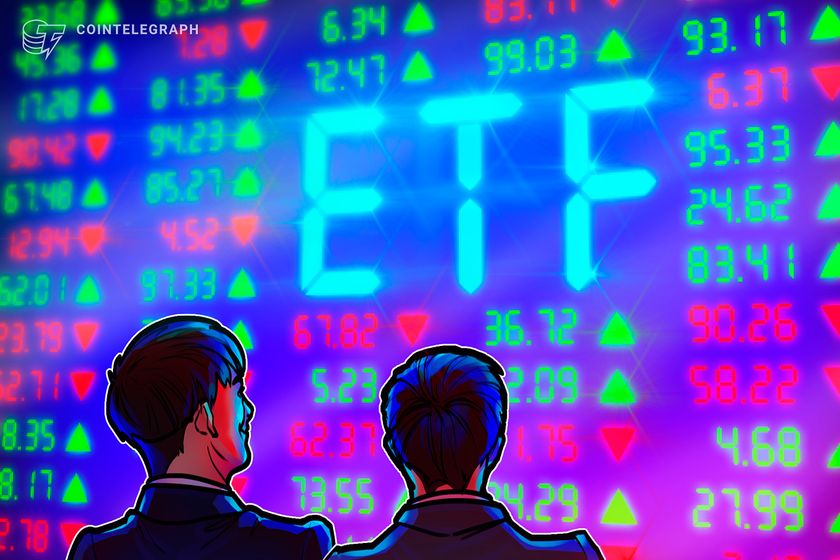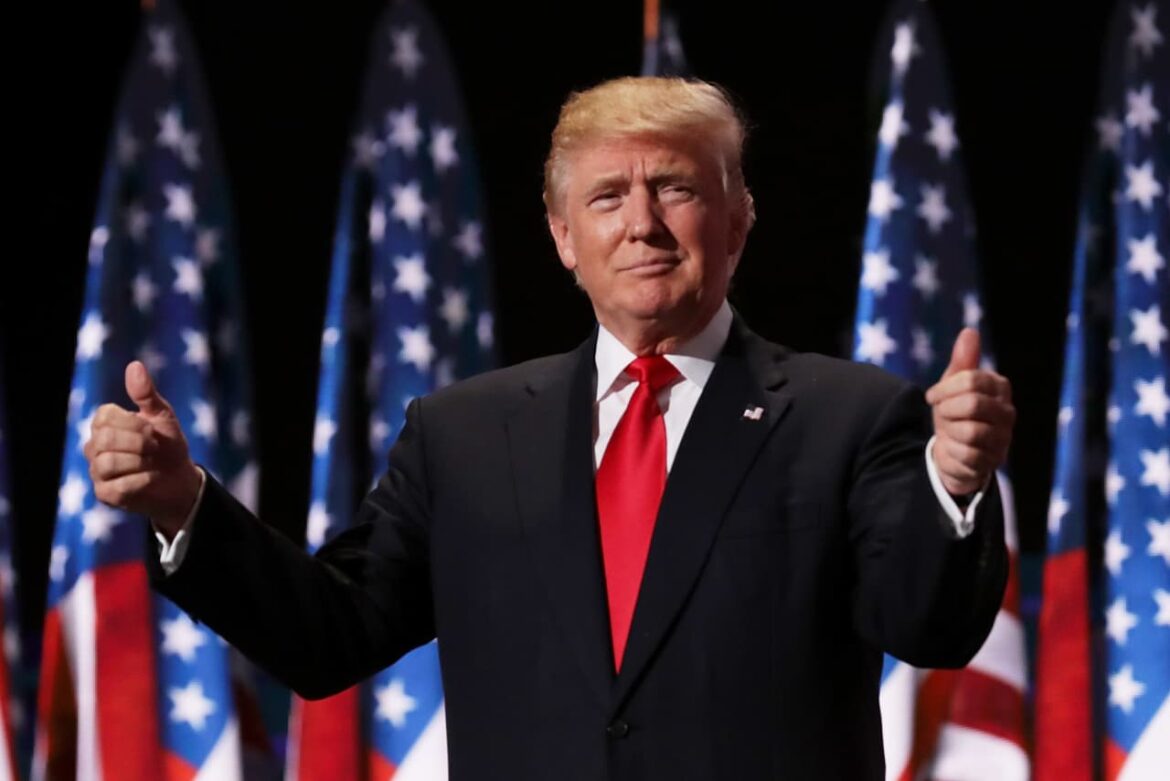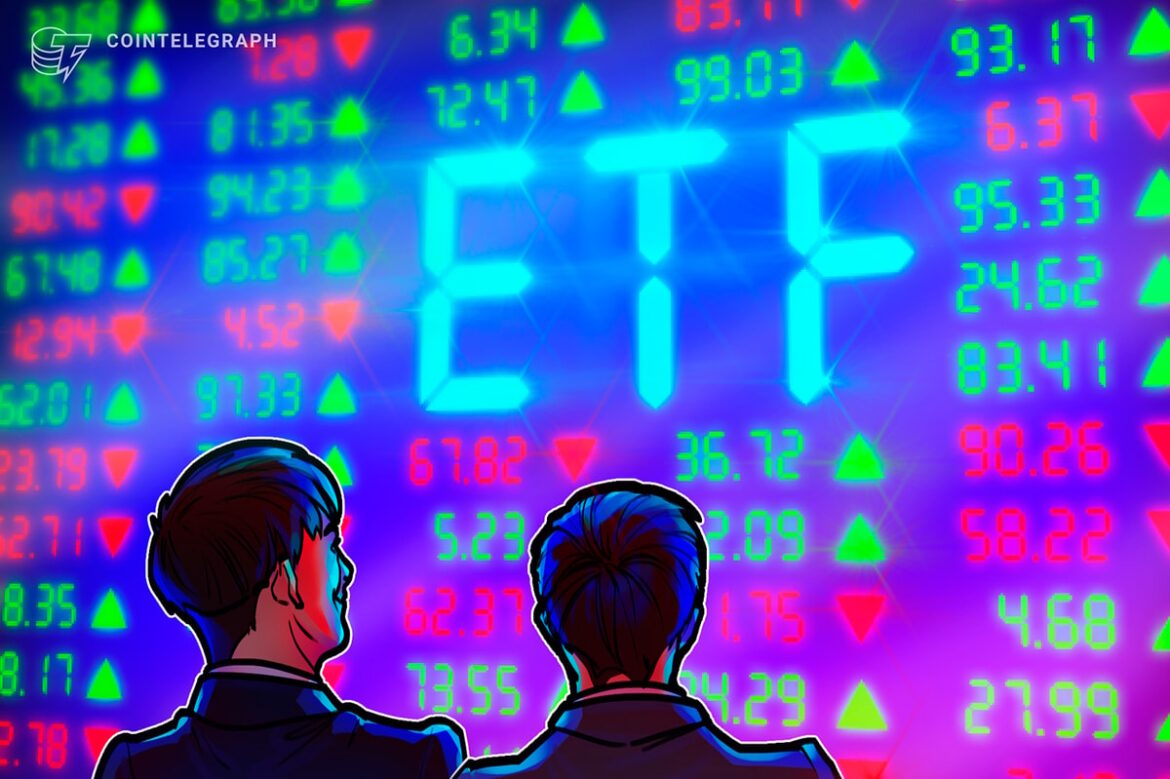
The Digital World blank-check company has officially changed its name to Trump Media & Technology Group. It begins trading Tuesday with the former president’s initials as its ticker symbol.
Source link
stake

AI firm Anthropic has blocked Saudi Arabia from engaging in the sale process of 8% of its shares — currently owned by defunct crypto exchange FTX, CNBC reported on March 22, citing people familiar with the matter.
FTX is selling the stake as part of its bankruptcy proceedings to repay its creditors, who lost billions due to its collapse. Investment bank Perella Weinberg is managing the sale, which has reportedly drawn interest from multiple sovereign wealth funds.
The sale is expected to be completed in the coming weeks.
National security risk
Saudi Arabia, despite its aggressive investment diversification efforts under Crown Prince Mohammed bin Salman’s “Vision 2030 Initiative,” has been barred from investing in Anthropic.
According to the report, Anthropic founders Dario and Daniela Amodei, who have ties to FTX founder and former CEO Sam Bankman-Fried through the effective altruism community, told bankers not to sell the stake to Saudi Arabia. The two are broadly uninvolved in the discussions but retain the right to vet potential investors.
Anthropic’s decision reportedly stems from considerations of national security and geopolitical complexities, including Saudi Arabia’s relations with China and its controversial human rights record, highlighted by incidents such as the alleged assassination of journalist Jamal Khashoggi in 2018.
The AI firm may be wary of selling the shares to Saudi Arabia as AI is considered a “dual-risk” technology that has both civilian and military use cases.
However, the company has not attempted to exclude other countries from participating in the sale — with the UAE’s Mubadala still in the running.
The US government has also raised concerns about the sensitive nature of AI in relation to national security in recent weeks.
The Committee on Foreign Investment in the United States (CFIUS) has the authority to block foreign investments that are deemed a threat to national security and may choose to intervene in the sale process considering the heightened interest from foreign state-backed entities.
Shares now worth $1 billion
Originally purchased by FTX for $500 million in 2021, the stake’s value has significantly increased in the wake of the AI sector’s rapid expansion and is worth more than $1 billion as of press time.
The sale of class B shares, which do not offer voting rights, is priced based on Anthropic’s last valuation of $18.4 billion and amounts to more than $1 billion as of March.
The sale of FTX’s Anthropic stake is part of the former company’s bankruptcy case. A court ruled that FTX could sell the stake in February. Sale proceeds will partially go toward compensating investors affected by the collapse of FTX, satisfying a concern that was raised when the court greenlit the sale last month. Estimates from mid-2023 suggest FTX owes customers about $8.7 billion.
Mentioned in this article
Latest Alpha Market Report

A hedge fund has bought a 5% stake in the U.K.’s largest commercial television broadcaster ITV, as the broadcaster struggles against a slump in the advertising market that has pummeled its share price in recent years.
Silchester International Investors LLP, whose offices sit at the heart of Mayfair, just minutes from both Berkeley Square and Saville Row, has acquired an almost £120 million ($152 million) holding in ITV, regulatory filings show.
Shares in ITV
ITV,
fell 1% on Tuesday having lost 33% of their value over the previous year, as a slump in the advertising market has hit the free-to-air broadcaster’s revenue.
Silchester, which was started in 1994, describes itself as “specializing in international equity investment on behalf of institutional investors” and says its aims to generate “attractive long term return through investment in quoted international equities.”
In outlining its investment philosophy, the hedge fund, which has previously built stakes in major British companies including Tesco
TSCO,
and GSK
GSK,
says it “seeks to identify companies capable of increasing earnings, assets and dividends by their own efforts.”
The publicity-shy hedge fund, which was set up by former Morgan Stanley banker Stephen Butt, has previously invested in some of the world’s major television broadcasters and media companies, including Luxembourg’s RTL Group
RRTL,
and Hong Kong’s TVB.
In 2022, Silchester was revealed to have become WPP’s
WPP,
third-largest investor, having built a £500 million stake in the British advertising giant, in investments that led to speculation the fund would push for a break-up of the multinational communications firm.
The Mayfair hedge fund derives its name from an ancient settlement in Berkshire that was founded by a Celtic tribe during the Iron Age before being taken over by the Romans in 45 AD.
Silchester’s acquisition makes it ITV’s seventh largest shareholder, behind telecommunications company Liberty Global
LBTYA,
(9.83%) and asset managers Brandes Investment Partners LP (5.83%), RWC Asset Management (5.63%), Schroder Investment Management (5.2%), Artemis Investment Management (5.1%), and Threadneedle Asset Management (5.07%).
ITV, which launched as the U.K.’s first privately-owned television broadcaster in 1955, generates revenue by selling advertisement on TV and also by producing shows that it sells to broadcasters including Amazon Prime and the BBC.
The London company has suffered financially from a drop in spending on television adverts, as viewers have turned away from watching traditional TV broadcasts in switching to using streaming services including Netflix and Amazon Prime.
ITV has, however, seen revenues from its studio business increase in recent years, on the back of the popularity of shows including Love Island and Come Dine With Me.
Earlier this year, ITV’s drama Mr Bates vs. the Post Office, which covers the U.K.’s horizon post office scandal, became the broadcaster’s most successful new drama in a decade, after drawing in 14.8 million viewers.
A spokesperson for Silchester International Investors declined to comment.
Op-ed: Proof of Stake – Meet the new inequality, same as the old inequality?

The following is a guest post from John deVadoss.
The promise of cryptoeconomics lies in its moon-shot ambition of creating new economic platforms, built on the aspirational ideas of decentralization and democratization and enabling inclusive and equitable governance models, thereby leveling the playing field for the common man.
We are at a decisive fork in the road for the industry, where most of the energy, as well as capital, is being prioritized towards Proof of Stake and staking, liquid staking, re-staking etc. Let us take a quick look back at history and examine the implications of what this entails for the average Joe.
The History of Capital: Wealth vs Income
In old English the term “capital” appears to have been used as an adjective meaning “of or relating to the head.” It is derived from the Latin root capitalis, meaning “of the head”, and was used to symbolize head of cattle. For ages, cattle have been sources of wealth; both in the short-term milk-related products as well as in the longer-term accrual and growth to the herd.
In its journey from the pastures to the marketplace, the term “capital” began to be used to capture the near-term kinetic dimension of an asset as well its longer-term potential dimension in creating surplus value. In the vernacular, capital is conflated with money and money is too often confused for capital.
Capital may be tracked in monetary terms, and money may be used to facilitate capital transactions, but in and of itself money cannot and does not initiate additional production. In other words, capital is about return while money is mostly about liquidity,
Income is transient; wealth is enduring. But how does wealth endure and grow?
The Mystery of Capital: Growth vs Distribution
The Nobel prize winning economist Simon Kuznets was a pioneer in considering the relation between economic growth and the distribution of income and capital. Kuznets collected data on economic growth and income inequality in the USA, UK, and Germany. His hypothesis was that as countries develop and their GDP grows, inequality first rises, but then it peaks and begins to fall.
Early criticism of the so-called Kuznets Curve was directed at the small data sets that he observed, especially during a time period buffeted by a series of economic shocks – the Great Depression, the World Wars, as well as the onset of the Cold War. However, his theory was consistent with mainstream economics and provided a reassuring platform for accelerated growth.
It was left to the unconventional French economist Thomas Piketty for the definitive dismantling of the Kuznets curve orthodoxy. Piketty studied the evolution of income and capital inequality and collated extensive data, from the 18th century through to the 21st century. His analysis demonstrated conclusively that capital outpaces income; and that there was no decrease in inequality as economic growth matures.
As Piketty says, when he started investigating the theoretical models of economic growth, he realized that there was often very little real data involved in the creation and the project of these models. His judgment is that often economists spend too much time doing theory and too little time on data collection and analysis.
Piketty’s key ideas are the wealth-to-income ratio and the correlation of the rate of return on capital to the rate of nominal economic growth. Over the last two hundred years of data, the only significant weakening of capital’s economic share and the resulting decrease in economic inequality can be ascribed to the impact of the World Wars, which devastated capital.
From Piketty’s analysis, the mid-20th century era of falling inequality was an outlier, resulting largely from the burdens of multiple wars and the concomitant need for high taxation. His analysis demonstrates that, in the long run, inequality arises not from the gap between those who earn high incomes versus those that don’t, but between people who inherit large amounts of capital and those that don’t.
Talking of the concentration of capital, and its inheritance, leads one to the question: what is the distribution of capital in crypto-economic networks?
The Quandary of PoS: Decentralized Proof of Inequality
Proof-of-stake is posited as a way to attest that network participants have placed something of value into the network and which may the be penalized if their behavior is not in accordance with the rules laid down by the governors of the network. Participants receive rewards proportional to their stake for behavior that is concordant with the rules.
Typically, to participate in a PoS network, one must deposit a minimum amount of capital (the “stake”). If you have the capital, then you may play; if you don’t then you find one of a small number of increasingly (already) centralized validator cartels to pool your stake and to be rewarded.
For instance, in Ethereum‘s PoS model, validators stake capital in the form of ETH into a smart contract. The validator is then responsible for verifying that new blocks broadcast over the network are valid and may also choose to create and propagate new blocks of their own accord. If a validator tries to contravene the rules, then some or all of their stake may be penalized.
PoS ensures that capital produces revenue, which ought to put Adam Smith at ease, but, given that the base token holders are too often significantly concentrated, are we then witnessing the preamble of a digital quandary, between the low inequality that is required for systemic stability, and the high centralization reality of most early-stage crypto-networks ?
From the narrow confines of a Scope One emissions perspective, PoS may be seen as being superior to PoW; however, Piketty’s evidence-based insights foretell the inevitable economic crisis resulting from this digital decentralized inequality. Crypto-economists would do well to incorporate Piketty’s data-driven insights.
Celestia is the star of the modular network in late 2023 after its airdrop and staking TIA has become a good way to receive airdrops. Celestia is a chain that a lot of people overlooked because, before the launch, there was not a lot of information about Celestia and the airdrop. However, in the fast-paced world of cryptocurrency, overlooked gems can often surprise the market, and Celestia Network is no exception.
Celestia (TIA) Airdrop And What People Missed
Celestia network had stayed out of the limelight until it announced an airdrop eligibility site. Lots of people didn’t bother checking if they were eligible for an airdrop, because they felt it was irrelevant, people didn’t claim their airdrop at the deadline as requested by the team, which made the team extend the date to give more people the chance to claim.
At the end of the claim period, there were a lot of unclaimed airdrops to the extent the team had to distribute all the unclaimed airdrops to the wallets that claimed their airdrops, meaning that eligible wallets got double their initial allocations.
After the airdrop, the team focused on developing and creating utility for their chain, making the price of TIA skyrocket, as the demand for the chain and its token started to grow.
TIA Utility: Data Availability and Scalability
Celestia gives great utility towards Data Availability and Scalability giving other chains or upcoming chains a foundation to learn and work on. The Celestia team’s innovative approach, combined with partnerships and a focus on utility, set it apart in a crowded space.
In this guide, we will delve into the dynamics of Celestia, explore its transformative airdrop strategy, and discuss how staking TIA can position you for not only handsome rewards but also exclusive airdrops.
Unlike many projects that fizzle out post-airdrop, Celestia took a different path. The team continued developing the platform, adding significant utility to the Celestia chain. This utility, focused on data availability and scalability, spurred demand for the native token, TIA, ultimately driving its price higher.
Celestia (TIA) Network Collaborations
Celestia has partnered with most roll-ups of other chains like the Manta network which is another rollup that has been able to combine utility from the calamari network, and the EVM network. Collaborating with Celestia for better scalability and data availability increased the demand for Celestia(TIA).
Celestia (TIA) Network Airdrop Distribution
Celestia changed the way they distributed their TIA airdrop, which was different from what the market was used to. The Celestia pre-launch had incentivized node running events, rewarding node runners, but that was not enough to bring more people into exploring its ecosystem, it had to distribute its airdrop by rewarding all EVM users. If you had interacted on the EVM chain, you were eligible for the TIA airdrop.
Now, let’s delve deeper into the details surrounding TIA staking, Celestia’s impact on the crypto space, and the broader implications for investors seeking to navigate this dynamic landscape.
Reasons To Stake TIA
Staking TIA offers a multifaceted investment strategy, combining an attractive Annual Percentage Rate (APR), potential airdrop eligibility, and the broader positive trajectory of the Celestia platform. Taking a closer look at TIA staking, investors are drawn by the appealing APR, often exceeding 10%.
However, it’s essential to note that the choice of validator plays a crucial role in determining the staking rewards. As the Celestia platform continues to innovate and gain prominence, the allure of TIA staking is further heightened.
Celestia’s commitment to enhancing scalability and data availability. This, in turn, has led to increased demand for TIA, solidifying its position as a valuable asset within the crypto market.
Celestia’s unique utility and game-changing capabilities have positioned it as a frontrunner in the blockchain space. As a result, any new chain looking to launch and conduct a successful airdrop finds integrating TIA stakers as an effective strategy to garner attention. This is particularly true for projects building on the Celestia platform, where TIA’s association adds a layer of credibility and visibility
The association of TIA with projects like Dymension, where TIA stakers met airdrop eligibility criteria, underscores the growing trend of projects leveraging TIA stakers for increased visibility and credibility. As more projects within the Celestia chain ecosystem emerge, the potential for additional airdrops targeted at TIA stakers becomes increasingly promising.
While this analysis sheds light on the potential benefits of staking TIA, it’s crucial to acknowledge the ever-changing nature of the crypto market. Therefore, individuals considering TIA staking should conduct thorough research and stay updated on market trends to make informed decisions.
Exchanges to Buy Celestia (TIA)
To embark on the journey of acquiring TIA, one can explore various prominent exchanges where TIA is listed. Platforms such as Binance, Kucoin, OKX, and Bybit offer a convenient gateway for purchasing TIA.

A critical component of the staking process is securing a Keplr wallet. The Keplr wallet is an essential tool for managing and staking TIA securely. Users can download the wallet, create a new wallet by saving the seed phrase, and take precautions to safeguard their keys. The importance of protecting access to one’s crypto assets cannot be overstated, as the security of the Keplr wallet directly correlates with the safety of the stored TIA holdings.
How to Get Your TIA Wallet Address
Go to your Keplr wallet and get your TIA address. You can get it by typing TIA in the search bar, but if it’s not available, you have to make it available.
Click on the hamburger sign at the top left corner:

Click on Manage Chain Visibility next, type TIA, enable it, and Save it:

Go to your wallet dashboard and copy your TIA address, remember, the address is supposed to start with “Celestia”. Go to your crypto exchange and send TIA to that address.
The process of obtaining TIA is straightforward, with the cryptocurrency available across major exchanges. Additionally, users can explore the option of bridging from other Cosmos chains, such as converting ATOM on the Cosmos chain or INJ on the Injective chain to TIA.
Once TIA is secured in the Keplr wallet, staking becomes the next logical step. Users can access the Celestia Staking dashboard on Keplr, choose a validator based on their preferences, and stake their TIA accordingly. Choosing a validator that offers a high percentage of rewards is best.
It’s important to note that unstaking TIA involves a 21-day processing period, requiring users to plan their actions accordingly.
Protect Your Staked TIA
Securing a Keplr wallet is paramount for those looking to engage in TIA staking. The wallet serves as a secure tool for managing and staking TIA, requiring users to download it, create a new wallet with a saved seed phrase, and take necessary precautions to safeguard their private keys.
Never store your seed phrase in a place where it can be accessed on the internet. Do not copy your seed phrase on your device. It is best to write down your seed phrase on a piece of paper and keep it in a place only you can access.
CONCLUSION
It’s crucial to emphasize that the information provided here is not financial advice, but rather an analysis of the current trends in the crypto market. However, the logic behind acquiring TIA and staking is compelling.
The demand for TIA has been on a consistent uptrend, driving its value from an initial $2.2 to well over $10. The combination of robust staking rewards and the prospect of participating in airdrops makes TIA an enticing asset for investors looking to maximize their returns.
TIA price crosses $13 | Source: TIAUSD on Tradingview.com
Featured image from BSC News, chart from Tradingview.com
Disclaimer: The article is provided for educational purposes only. It does not represent the opinions of NewsBTC on whether to buy, sell or hold any investments and naturally investing carries risks. You are advised to conduct your own research before making any investment decisions. Use information provided on this website entirely at your own risk.
Alibaba reduces stake in GoGoX amid Hong Kong logistics services firm’s mounting losses, as it faces cutthroat competition on the mainland
Chinese e-commerce giant Alibaba Group Holding has further reduced its stake in Hong Kong-listed logistics service provider GoGoX Holdings, which is facing cutthroat competition and regulatory pressure in the mainland’s intracity delivery courier market.
Alibaba, which owns the South China Morning Post, has cut its GoGoX stake four times over the past two months, slashing its equity holding to 8.89 per cent as of late December from 12.23 per cent in mid-2023, according to Hong Kong stock exchange records.
Following those moves, the biggest shareholder of GoGoX remains billionaire Yao Jinbo – the founder, chairman and chief executive of mainland Chinese online classifieds giant 58.com – with a 38.69 per cent share. GoGoX co-founder Chen Xiaohua, with a 5.95 per cent stake, retains his position as the company’s third-biggest shareholder.
Do you have questions about the biggest topics and trends from around the world? Get the answers with SCMP Knowledge, our new platform of curated content with explainers, FAQs, analyses and infographics brought to you by our award-winning team.
Founded as GoGoVan in Hong Kong in 2013, GoGoX became the city’s first unicorn in 2017 after its merger with short-distance freight service platform operator 58 Suyun. Still, GoGoX has recorded losses since 2018 owing to stiff competition on the mainland and its continued international expansion.

GoGoX, one of Asia’s first mobile app-based logistics services platform operators, has expanded its operations over the years from Hong Kong to mainland China, Singapore, South Korea, India and Vietnam. Image: GoGoX alt=GoGoX, one of Asia’s first mobile app-based logistics services platform operators, has expanded its operations over the years from Hong Kong to mainland China, Singapore, South Korea, India and Vietnam. Image: GoGoX>
GoGoX, which operates as Kuaigou Dache on the mainland, has seen its market value shrink by more than 90 per cent since its Hong Kong trading debut in June 2022. Its share price closed up 6.8 per cent to HK$0.63 on Thursday.
The company – which expects to remain in the red this year, according to its 2022 prospectus – narrowed its losses to 642.9 million yuan (US$90.37 million) in the first half of 2023, from 1.05 billion yuan in the same period in 2022.
GoGoX also went through a major management reshuffle in December, as founder Chen resigned from his chairman role. The company tapped Steven Lam Hoi-yuen, another co-founder and the co-chief executive of GoGoX, as its new chairman.
Hangzhou-based Alibaba’s partial divestment initiative at GoGoX comes amid its preparations for the initial public offering (IPO) of Cainiao Smart Logistics Network, which submitted its A1 filing to the Hong Kong stock exchange last September.
Cainiao aims to raise at least US$1 billion, subject to market conditions, according to sources cited in a Post report that month.

Steven Lam Hoi-yuen, co-founder and co-chief executive of GoGoX, hits the gong during the company’s listing ceremony at the Hong Kong stock exchange on June 24, 2022. Photo: Dickson Lee alt=Steven Lam Hoi-yuen, co-founder and co-chief executive of GoGoX, hits the gong during the company’s listing ceremony at the Hong Kong stock exchange on June 24, 2022. Photo: Dickson Lee>
Alibaba is trying to stop the bleeding with its stake cut, as its initial goal with the GoGoX investment was to gain financial returns through the listing and create synergy with its own services, according to Zhang Yi, founder and chief analyst at Guangdong-based consultancy iiMedia.
“This is still a market with huge demand and many opportunities even with the price wars, similar to those in the bike-sharing and ride-hailing sectors,” Zhang said. “So the bigger problem is more likely to lie within the operation of GoGoX, which will need revolutionary measures to reverse its losses.”
At present, GoGoX is competing in a crowded on-demand cargo delivery services market on the mainland, where its hometown rival Lalatech Holdings operates Huolala. Competition has become more intense in recent years after traditional logistics firms and ride-hailing companies also set up similar app-based courier delivery operations.
Chinese ride-hailing giant Didi Chuxing, for example, started its own intracity freight service in 2020 and launched its autonomous trucking business Kargobot in April last year. Full Truck Alliance, known as China’s “Uber for trucks” and focused on long-haul logistics services, in April launched its Sheng Sheng brand dedicated to same-city delivery.
Huolala currently leads the mainland’s intracity courier delivery services market with a 61 per cent share, according to Frost & Sullivan data cited in the prospectus of Lalatech, which is eyeing a Hong Kong IPO.
Similar to on-demand services like ride hailing, the early stage of competition in intracity freight services has relied heavily on subsidies for users.
That “cash-burning” business model, however, has faced increased scrutiny from regulators, who recently summoned Lalatech for talks regarding drivers’ rights and unfair price cuts.
GoGoX and other courier delivery services providers have also received “reminders” from regulators about their operations in the past year.
This article originally appeared in the South China Morning Post (SCMP), the most authoritative voice reporting on China and Asia for more than a century. For more SCMP stories, please explore the SCMP app or visit the SCMP’s Facebook and Twitter pages. Copyright © 2024 South China Morning Post Publishers Ltd. All rights reserved.
Copyright (c) 2024. South China Morning Post Publishers Ltd. All rights reserved.
The Tokyo-based Monex Group intends to further strengthen its digital asset offerings to institutional investors through the 3iQ acquisition.
Monex Group Inc, a holding financial company based in Japan with operations around the world, will acquire Canada-based crypto asset manager 3iQ Digital Holdings Inc for an undisclosed amount. According to the announcement, 3iQ will collaborate with Coincheck Inc, a Japanese cryptocurrency exchange with different products in the market that was acquired by Monex Group back in 2018 for about $33.4 million, to bolster the digital asset offerings focused on institutional investors. Additionally, the partnership will entail enhanced liquidity for the 1.8 million Coincheck customers already invested in the cryptocurrency industry.
Frederick T. Pye, Chairman and CEO of 3iQ, expressed his support for the groundbreaking initiative that is geared towards reshaping the web3 and digital assets industry. Moreover, 3iQ has specialized in tailored products for institutional investors seeking to tap into the cryptocurrency market.
“This partnership is not just about growth; it’s a thrilling leap towards realizing our dream. We’ve always been passionate about bringing regulated, innovative digital asset products to investors worldwide, and now, with Monex Group, we can turbocharge this mission,” Pye noted.
Similar sentiments were echoed by Yuko Seimei, the Chief Executive Officer of Monex Group, who insisted that the collaboration between the two entities will streamline the mass adoption of digital assets. Moreover, the Japanese government has already enacted notable clear crypto regulations to welcome international investors to tap into the local growing demand.
“Our long-term strategy is to strengthen our asset management business, and by welcoming 3iQ to our group, we aim to achieve high growth by capturing the crypto asset management needs of institutional investors and crypto asset exchanges around the world, which are expected to grow in the future,” Seimei noted.
Market Implications of the 3iQ Acquisition by Monex Group
The Monex Group was impressed by the fact that 3iQ’s Bitcoin and Ethereum exchange-traded funds (ETFs) on the Toronto Stock Exchange have significantly grown since their inception. Notably, the 3iQ Bitcoin ETF (TSX: BTCQ) traded around CA$ 9.11 on Friday, down approximately 2 percent in the last 24 hours. Nonetheless, the BTCQ fund has registered more than 124 percent gains year-to-date, following the impressive Bitcoin performance. Other notable funds offered by 3iQ include the 3iQ Ether Staking Fund and the 3iQ Global Cryptoasset Fund.
The acquisition of 3iQ will play a huge role in bolstering revenues for Monex Group and its stock market. Moreover, 3iQ has introduced more products – including the recently unveiled 3iQ Managed Account Platform (QMAP) – that are geared towards enabling the seamless adoption of digital assets by institutional investors. According to the latest market data, Monex Group stock has gained about 70 percent since the calendar flipped in January.
next
Business News, Deals News, News
You have successfully joined our subscriber list.
Manchester United’s stock rises after Jim Ratcliffe clinches 25% stake

Manchester United’s stock climbed Tuesday after British billionaire Jim Ratcliffe clinched his 25% minority stake in the iconic English soccer club.
Shares of operator Manchester United Ltd. MANU rose 2.4%, outpacing the S&P 500 index’s SPX gain of 0.4%.
Manchester United announced the agreement on Dec. 24, with Ratcliffe acquiring 25% of…
Master your money.
Subscribe to MarketWatch.
Get this article and all of MarketWatch.
Access from any device. Anywhere. Anytime.
Already a subscriber?
Log In
Former Microsoft CEO Steve Ballmer is on pace to earn $1 billion in dividends annually from his massive stake in the software company
-
Steve Ballmer is on pace to collect annual dividend payments of $1 billion from Microsoft.
-
He is the former CEO of Microsoft and is the largest individual shareholder of the software giant.
-
Ballmer’s Microsoft stake has surged to a value of $128 billion this year following Microsoft’s 55% stock rally.
Microsoft is on track to pay former CEO Steve Ballmer about $1 billion in annual dividend payments.
Ballmer, who is currently the sixth richest person in the world, is the largest individual shareholder in Microsoft. As of his last ownership disclosure in 2014, Ballmer owned 333.2 million shares of Microsoft, representing about 4% of the company.
Ballmer’s stake is worth about $130 billion, according to Bloomberg’s Billionaire Index, after gaining $44 billion in wealth this year thanks to a 56% rally in Microsoft’s stock price.
Ballmer amassed his stake over the course of his 34-year career at Microsoft, having joined the company in 1980 as employee number 30. He went on to become CEO of Microsoft in 2000, near the peak of the dot-com bubble, and stepped down in 2014 when current CEO Satya Nadella took over the top role.
Microsoft paid $2.79 in dividends per share in 2023, which equates to an annual dividend payment of about $930 million to Ballmer based on his stake in the company.

That payout is set to increase in 2024, as Microsoft lifted its dividend 10% recently to pay $3 per share a year. That would equate to an annual dividend payment of $999.6 million to Ballmer in 2024, and it could be even higher assuming Microsoft continues its trend of hiking its dividend payment every year.
Microsoft has increased its dividend payment for 18 consecutive years, so its likely that Ballmer’s annual dividend payout will top $1 billion in 2024 and continue to grow in the coming years.
Ballmer’s massive stake in Microsoft has put him within spitting distance of becoming the fourth richest person in the world, as he’s just a few billion dollars behind Larry Ellison and his former boss, Bill Gates.
Gates has significantly diversified his wealth away from Microsoft and towards cash and other public equities since he stepped down from the company. In fact, in 2014, Gates also owned about 4% of Microsoft, having a 330 million share stake in the company. But multiple divestitures over the years has led Gates to owning just over 1% of the software giant.
Read the original article on Business Insider

TMX Group, the operator of Canadian stock exchanges such as the Toronto Stock Exchange and the Montreal Exchange, is finalizing the acquisition of VettaFi, a significant player in the exchange-traded fund (ETF) industry, including in blockchain and crypto ETFs.
The firm officially announced on Dec. 13 that it has agreed to acquire the remaining 78% of the common units of VettaFi for $848 million that it didn’t already own. The new deal brings the total amount of the acquisition to $1.03 billion, which includes investments TMX Group made in VettaFi in the first half of 2023 for around 22% of the common units, the announcement notes.
“The acquisition of VettaFi will add a dynamic new component to our growing information business, with an exciting set of capabilities and a visionary, innovative team committed to client success,” TMX Group CEO John McKenzie noted. He added that TMX had previously worked with VettaFi, and their collaboration had brought a “powerful combination and a tremendous culture fit.”
Related: Bitcoin for Christmas: MicroStrategy buys another $600M
VettaFi was founded in May 2022 when the teams from ETF Trends, ETF Database, Alerian and S-Network Global Indexes merged to form one joint company. VettaFi provides a comprehensive suite of global indexes and ETF services, including ETF trends and analytics, a global ETF database and other tools.
Apart from traditional finance ETFs, VettaFi lists blockchain and cryptocurrency-themed ETFs, including the VanEck Digital Transformation ETF, which has surged nearly 207% year to date.
Magazine: How to protect your crypto in a volatile market — Bitcoin OGs and experts weigh in










